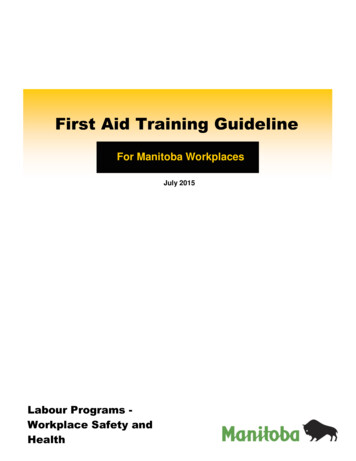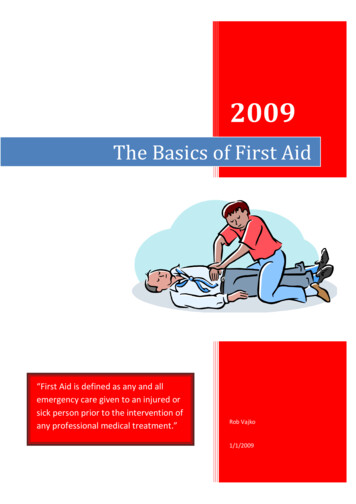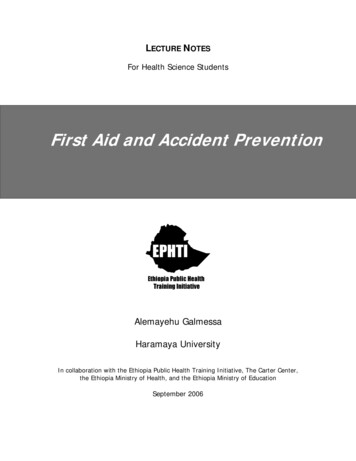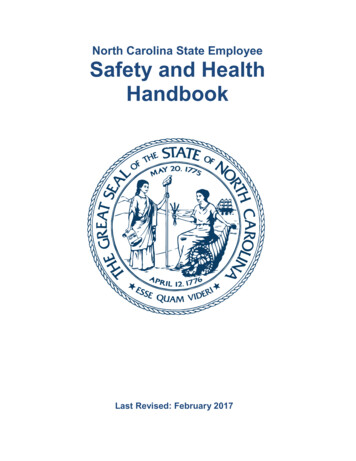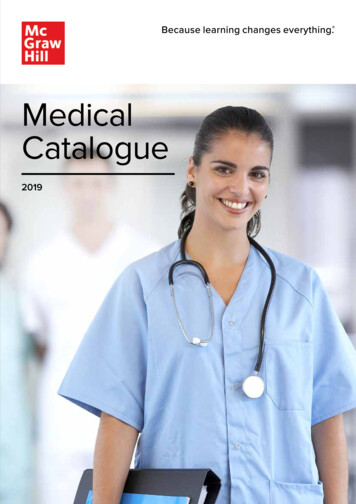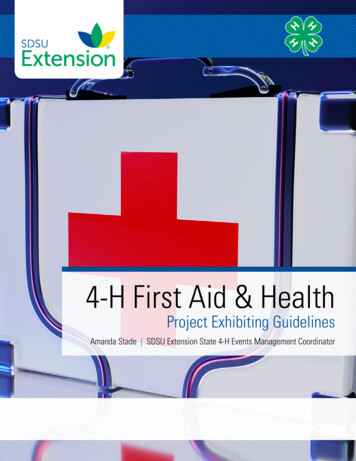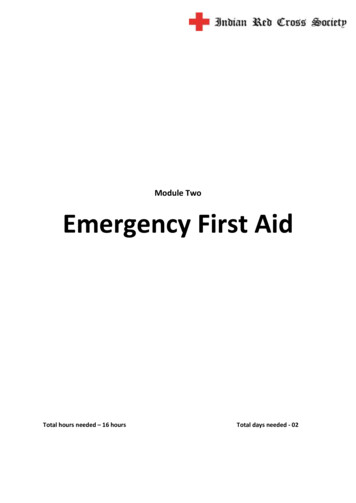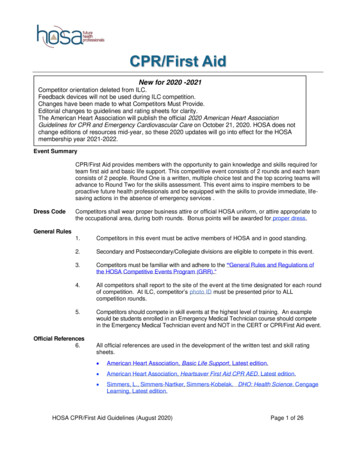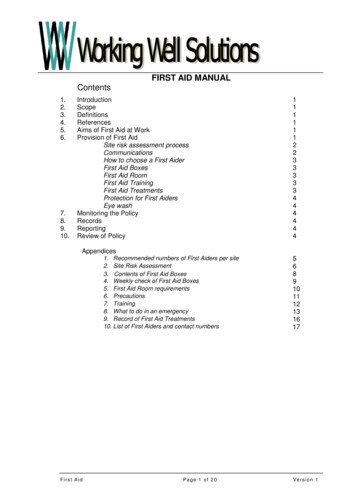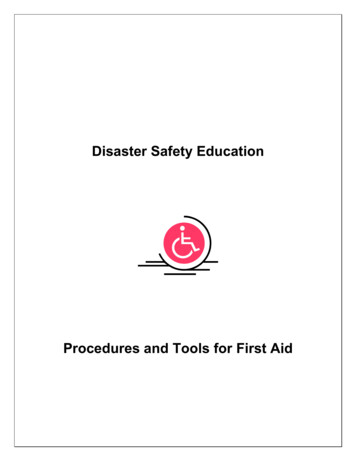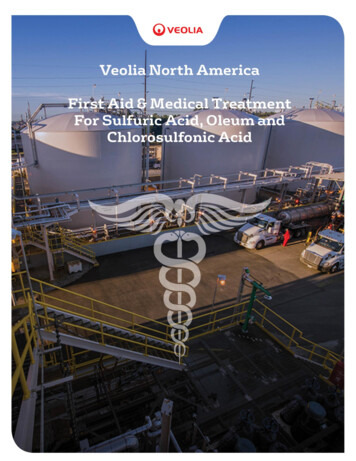
Transcription
1
First Aid and Medical Treatment Manual for Sulfuric Acids ResponseVeolia North America Rev 05/29/2018Disclaimer:Please note specifications and technical information are provided for guidance only and are intended to supplement,but not replace, user’s design and safety criteria. The information is believed to be reliable; however no warranty ofany kind, express or implied, is made with respect to the data or the references. The use of any part of this documentis at the user’s sole risk, and we make no guarantee of results and assume no responsibility or liability for resultsobtained or damages incurred from use of the data in whole or in part. The information provided here is intended foruse by responsible personnel having appropriate skills and know-how. Information provided may not be all-inclusive,and suitability to local laws, codes and practices shall be confirmed by the user of this information.First Aid Treatment for Sulfuric Acid ExposuresIncluding Oleum and Chlorosulfonic AcidGeneral:Exposure to sulfuric acid can cause skin burns, corneal ulceration of the eyes, and respiratory irritation.Small exposures may cause: Skin irritation with discomfort or pain.Eye irritation with discomfort, tearing or blurring of vision.Upper respiratory system irritation manifested by coughing, throat irritation and choking sensation.Larger exposures may lead to: Skin burns or ulceration.Eye corrosion with corneal or conjunctival ulceration.Respiratory irritation manifested by coughing, discomfort, difficulty in breathing, or shortness of breath.High or prolonged exposures may cause delayed lung edema.Personnel who handle sulfuric acid are to be thoroughly trained and drilled in first aid procedures for handling theseburns and other exposures. This section provides information that will be used when first aid and medical treatmentare required.1. FIRST AID:Speed in removing personnel from the contaminated area and in removing the sulfuric acid from the skin and eyes isof primary importance. First aid should be started immediately when there is contact with sulfuric acid in anyform.Veolia North AmericaRegeneration Services131 Continental Drive, Suite 300Newark, DE 19713Tel ation-services2
First Aid and Medical Treatment Manual for Sulfuric Acids ResponseVeolia North America Rev 05/29/2018Inhalation:Immediately remove the patient to an uncontaminated atmosphere. Call a physician. Check for breathing and pulse.Start oxygen 100% at 6L/min. Check for other injuries. If not breathing, give artificial respiration. Keep the patientwarm and at rest.Skin Contact:Immediately shower exposed area(s) with large quantities of water after contact or suspected contact, andcompletely remove contaminated personal protective equipment, clothing, and shoes while in the shower. Flush theskin thoroughly with water for at least 15 minutes. Call for medical help while flushing the skin. Adequate flushingwith large quantities of water is extremely important. Only after flushing with water may one apply clean white terrytowels, specifically dedicated for first aid use, dipped in clean iced water, to the affected area. If ice water isn’tavailable, tepid water irrigation/compresses should be used. Continue applying the towels until a doctor or otherqualified medical personnel determines it should be stopped. If the injured is transported to a hospital or otheremergency facility, continue to re-apply the towel compresses during the trip.Do not freeze the burned area. Do not apply ice directly to any area.Do not use a cloth, rag or other object to try to “wipe” the acid off the skin. This will only delay thewater shower treatment and could cause a break in the skin, which could lead to infection.Caution: The first aid responder should anticipate shock when third or second degree burns of 9% body surfacearea (BSA) occur. See Figure 1, Rule of Nines, to determine the extent of BSA burned. Indications of shock arethe patient becoming pale, cold and clammy, or lightheaded. If the patient shows symptoms of shock, stop theice water treatment but continue to apply tepid water irrigation/compresses to the affected area and start oxygen100% at 6L/min, keep the patient warm and immediately raise his/her feet. Depending on the speed of localcommunity response and degree of training of the first aid responders, consideration should be given to starting anIV of normal saline via a large bore needle in an area free of burn.Caution: If the burn breaks the skin, use precautions to protect the person applying the treatments from potentialblood borne pathogens. Proper protective equipment (gloves, eye shields, etc.) shall be used. Do not use samebucket of water on multiple patients.Eye Contact:Immediately flush eyes with large quantities of water while holding eyelids apart. Continue flushing for at least 15minutes. Do not try to neutralize the acid. Call a physician immediately. Transfer the patient promptly to a medicalfacility. Apply cool packs to eyes during transport.Veolia North AmericaRegeneration Services131 Continental Drive, Suite 300Newark, DE 19713Tel ation-services3
First Aid and Medical Treatment Manual for Sulfuric Acids ResponseVeolia North America Rev 05/29/2018Ingestion:Do not induce vomiting. Give large quantities of water. Call a physician immediately and transfer promptly to amedical facility. Do not give anything by mouth to an unconscious person.2. Medical Treatment:Inhalation:Persons exposed by inhalation to large concentrations of the material shall be given 100% humidified oxygen (6liters per minute).Assess patient while continuing oxygen treatment. Evaluate for nasopharyngeal burns.Symptoms may vary from mild chest discomfort and slight cough, to severe cough, wheezing, and extremeshortness of breath. Physical examination may be normal or, may reveal mild rhonchi, wheezes or moist rales.Chest x-rays are usually normal at first, however changes may develop over 24-48 hours showing pulmonary edemaor infiltrates.WARNING: Any exposure or symptomatic patient(s) need to be assessed in a local hospital, preferablya tertiary care center (large hospital/burn center).For very brief exposures in asymptomatic patients:Give oxygen (100% at 6L/min) for 15 minutes and re-evaluate; if still asymptomatic observe for 15 - 30 minutes more.If symptomatic, give oxygen as above, and continue while transporting to local hospital, preferably a tertiary carecenter.If patient is referred to a hospital, send last chest x-ray and a copy of the last physical examination on file. Send acopy of the SDS. Do not delay transportation to the hospital if the information cannot be found immediately.If patient is not referred to a hospital, closely monitor respiratory function for 12-24 hours to assure pulmonary edemadoes not develop.Skin Contact:Third degree and deep second-degree burns should be referred to a local tertiary care center or localspecialist for definitive treatment. Small deep burns involving hands, face, feet or perineum should also bereferred.Follow up is needed, especially to detect delayed infection or other complications.Veolia North AmericaRegeneration Services131 Continental Drive, Suite 300Newark, DE 19713Tel ation-services4
First Aid and Medical Treatment Manual for Sulfuric Acids ResponseVeolia North America Rev 05/29/2018For first-degree burns and superficial small second-degree burns, treatment may be given at the site.After adequate flushing has been accomplished, cool down small burns by continuous irrigation with either white terrycloth towels, specifically dedicated for first aid use, dipped in ice water or with tepid water irrigation.Caution: Be alert for symptoms of shock, especially if large areas ( 9% BSA) are affected by the burn. Discontinueice water treatments if signs of shock are observed but continue tepid water irrigation/compresses and treat the shock.Evaluate exposed areas and determine if irritation or pain persists. Continue irrigation as long as pain persists.Consider pain medication. If exposure is a small area of contact and case will be managed by site medical, a medicalprotocol should be developed to allow for pain control (OTC or prescription, likely a non-steroidal anti-inflammatorydrug, check for allergy). If exposure is to be treated by local hospital (preferably tertiary care center) then allow themto determine appropriate pain medication.In the acute setting, do not cover exposure area with ointment /cream if the patient is to be seen for follow-upmedical care by local hospital or tertiary care center.If integrity of skin is compromised, apply dressing of impregnated gauze (Vaseline) or moist gauze (saline gauze) anda dry bulky dressing. Splint appropriately in neutral position if joints are involved. Use available precautions to protectfrom blood-borne pathogens.If integrity of skin is not compromised, apply moist dressing (saline gauze) and cover with a bulky dressing to protectaffected area from contamination or further trauma. Do not open blisters.Assess the need for prophylactic antibiotics on a case-by-case basis. Generally if the skin is intact, prescriptionantibiotic ointments and creams are not needed.Review tetanus status and consider tetanus booster if 10 years since last tetanus toxoid booster.Eye Contact:Eye exposures to strong acid pH* 2.5 need immediate referral to a local hospital, preferably a tertiary care centeror local ophthalmologist. Continue irrigation of eye(s) with water or normal saline while in transport.*Caution: Veolia manufacturing sites making or handling sulfuric acid shall consider treatment as strong acidexposure and handle as such.Exposures to weaker acid (pH 2.5)Rewash eye with 2 liters of normal saline being sure to retract and invert the upper lid. A topical anesthetic may aidin the patient’s tolerance during the irrigation. A useful endpoint is the normalization of the conjunctival pH. A pH of7.5 8.0 is near normal for pH of the conjunctival cul-de-sac.Veolia North AmericaRegeneration Services131 Continental Drive, Suite 300Newark, DE 19713Tel ation-services5
First Aid and Medical Treatment Manual for Sulfuric Acids ResponseVeolia North America Rev 05/29/2018Wait 10 minutes with a cool compress on the eye(s) between irrigation and the touching of the cul-de-sac with pHsensitive paper.The irrigation cycle can be repeated until the pH is 7.5-8.0.After irrigation has been completed and the eyes have been allowed to rest, the patient’s visual acuity can be testedand results documented.A Fluorescein strip examination shall be conducted to assess for corneal abrasion. Defects/abrasions in theconjunctival layer stain bright green under UV light.If an abrasion is noted or vision is not clear, a referral to a local ophthalmologist is required.If not referred, an antibiotic ointment may be instilled (site protocol) and consideration given to patching the eye. Reevaluate in 24 hours. If eye is patched, consider appropriate driving/work restrictions.Ingestion:Ingestions need to be transferred promptly to a tertiary care center for definitive treatment. Do not induce vomiting.Give large quantities of water. Do not give anything by mouth to an unconscious person3. MEDICAL SUPPLIES FOR FIELD AND SITE MEDICAL OFFICE:Objective:To ensure sites handling sulfuric acid have adequate procedures, supplies and equipment to treat persons exposedto them.Field:Safety showers and eyewashes (minimum 15 minute water supply) should be located in areas where there is thepotential for exposure. It is recommended an emergency "kit" be kept in a designated, readily accessible, andcentrally located area such as a control room or shift supervisor's office, if the site does not have ready access to amedical facility. The area should have a bucket, clean ice, drinking quality water, and clean (preferably sterile) whiteterry cloth towels available. The terry cloth towels should be pre-washed to remove the sizing and packaged in a ziplock bag. If the site does not have buckets and ice, then it should have drinking quality tepid water. The kit shouldcontain, as a minimum: Sterile impregnated gauze (Vaseline gauze) dressings Sterile saline gauze dressings Kerlix gauze wraps Sterile 4x4 inch gauze dressings Sterile normal saline solution (eye)Veolia North AmericaRegeneration Services131 Continental Drive, Suite 300Newark, DE 19713Tel ation-services6
First Aid and Medical Treatment Manual for Sulfuric Acids ResponseVeolia North America Rev 05/29/2018 Blanket, stored in a zip lock bagClean white terry cloth towels, stored in zip lock bagsEye patchesChecklist of contents (inventory)Set of instructions and procedures for first aid and medical treatmentPhone numbers of site medical personnel and local emergency number(s)SDS informationThe kit is intended to be used to initiate first aid and should go in the ambulance in the event the injured has to betransported to an off-site treatment center.The kit shall be kept sealed and a full inventory of the contents shall be made on a monthly basis.Medical Office:The following is recommended as a minimum inventory of medical supplies to be kept at the site medical facility.Note: Sites should evaluate how much to keep in inventory based on the extent and potential number of people thatmay be exposed. An analysis of injuries due to the worst case scenario may be used to make this determination.Supplies shall be inventoried at least every six months, including: Standard medical dressings Sterile Vaseline gauze dressings Sterile saline gauze dressings OTC (Neosporin, Triple ointment, A&D ointment) and prescription antibiotic ointments (Silvadene) Prepackaged clean (preferably sterile) sheets Cylinders of 99% USP oxygen. - blanket, clean (preferably sterile) White terry cloth towels, stored in zip lock bags. Sterile saline solution. Set of procedures for first aid and medical treatment Changes of clothes Decontamination facilities (eyewash/shower) Eye tray that contains:o Handheld flashlighto Ophthalmoscopeo Visual acuity chart (Snellen or Jaegar)o Sterile, cotton-tipped applicatorso Isotonic saline (2) 1000 ml bagso Sterile Fluorscein stripso Clean pH strips - Ultraviolet lampo Eye patchesSites should establish contact with local suppliers for the above and determine the availability (on short notice) ofsupplies such as oxygen, in the event of catastrophic emergency.Veolia North AmericaRegeneration Services131 Continental Drive, Suite 300Newark, DE 19713Tel ation-services7
First Aid and Medical Treatment Manual for Sulfuric Acids ResponseVeolia North America Rev 05/29/20184. TRAINING:Objective:To ensure sites handling sulfuric acid have an adequate number of people trained to provide first aid and the localhospital or trauma center has adequate information and training to provide treatment to personnel exposed tosulfuric acid/oleum.First aid procedures require training of the rescue team.In order to ensure proper first aid and medical treatment is provided to exposed or injured persons, sites shoulddevelop and conduct training programs for on and off site rescue teams. Sites should ensure local emergencyrooms/providers have been trained in handling chemical burns. Sites should share SDS information with localproviders so they understand the type of exposure(s) they might receive from a Veolia site. Knowledgeable personsshould prepare these training programs and training should be conducted on a frequency to ensure personnelremain competent in the techniques they will be expected to use. The recommended minimum frequency for rescueteam training is annually. Sites should ensure refresher training is provided periodically to local providers by theirinstitutions.Rescue Team-On Site Personnel:Training should be given to the site rescue team or whoever would be expected to assist the injured so first aid canbe initiated immediately. This training should be "HANDS ON". A site may choose to limit the number of personswho may administer oxygen, to ensure adequate training is maintained.Participants should be trained, as appropriate, on: Decontamination of exposed employees How and when to irrigate eyes with sterile saline solution How and when to administer oxygenRecords of personnel trained and date of training should be kept by the site.Off-Site Support Facilities:Periodically, site personnel should ensure local medical personnel have received training on the medicalmanagement of acute chemical exposures as part of their training or in-service programs.A primary off-site support facility should be selected and patients should be sent to that facility. Information aboutthe site, typical types of exposures and strength of the sulfuric acid should be shared with the off-site support facilitypersonnel. Periodic reviews should include visiting the facility, ensuring adequate supplies are available, andpersonnel are familiar with Veolia’s SDS information.Veolia North AmericaRegeneration Services131 Continental Drive, Suite 300Newark, DE 19713Tel ation-services8
First Aid and Medical Treatment Manual for Sulfuric Acids ResponseVeolia North America Rev 05/29/2018Figure 1 Rule of Nines:Veolia North AmericaRegeneration Services131 Continental Drive, Suite 300Newark, DE 19713Tel ation-services9
For first-degree burns and superficial small second-degree burns, treatment may be given at the site. After adequate flushing has been accomplished, cool down small burns by continuous irrigation with either white terry cloth towels, specifically dedicated for first aid
